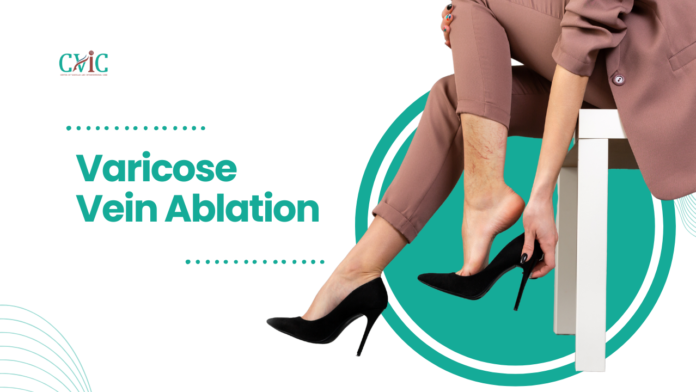Varicose vein ablation is a minimally invasive treatment option for varicose veins, a common condition where veins, usually in the legs, become enlarged, swollen, and often twisted. This condition not only affects the appearance of the legs but can also cause discomfort, pain, and sometimes more serious health problems. In this blog, we will explore what varicose vein ablation involves, its types, benefits, risks, and what to expect before, during, and after the procedure,Varicose Vein Treatment: Endovenous Laser Therapy.
What is Varicose Vein Ablation?
Varicose vein ablation is a medical procedure designed to close off varicose veins, improving blood flow and reducing symptoms. Unlike surgical stripping, ablation is less invasive and can be performed in a doctor’s office or outpatient setting. The procedure works by applying heat, laser light, or chemical substances to the inside of the vein, causing it to close and eventually be reabsorbed by the body.

Types of Varicose Vein Ablation
There are primarily two types of varicose vein ablation: thermal and non-thermal techniques.
- Thermal Ablation: This involves using heat to close the vein. The two main types are:
- Endovenous Laser Ablation (EVLA): A laser fiber is inserted into the vein, and laser energy is used to heat and close the vein.
- Radiofrequency Ablation (RFA): Similar to EVLA, but uses radiofrequency energy to generate heat.
- Non-Thermal Ablation: These methods do not use heat. Examples include:
- Mechanochemical Ablation (MOCA): Combines mechanical damage with a chemical sclerosant to close the vein.
- Cyanoacrylate Adhesive (VenaSeal™): A medical adhesive is used to seal the vein.
Benefits of Varicose Vein Ablation
Varicose vein ablation offers several benefits over traditional surgical methods:
- Minimally invasive with no need for general anesthesia.
- Reduced recovery time and minimal discomfort.
- Immediate return to daily activities, in most cases.
- High success rate and low recurrence of varicose veins.

Risks and Complications
While varicose vein ablation is generally safe, it can carry risks, such as:
- Infection at the puncture site.
- Deep vein thrombosis (DVT).
- Nerve damage, though this is rare.
- Skin burns or discoloration, particularly with thermal ablation methods.
Before the Procedure
Preparation typically involves:
- A detailed medical history review and physical examination.
- An ultrasound to map the veins and plan the procedure.
- Instructions to avoid certain medications or supplements that can increase bleeding risk.

During the Procedure
The procedure usually takes about an hour and involves:
- Local anesthesia to numb the treatment area.
- A thin catheter or probe inserted into the vein through a small incision.
- Application of the chosen ablation technique to close the vein.
- Removal of the catheter and application of a bandage or compression stocking.
After the Procedure
Post-procedure care is crucial for a successful recovery:
- Walking immediately after the procedure to encourage blood flow.
- Wearing compression stockings for a specified period to support vein closure.
- Avoiding prolonged standing or sitting, heavy lifting, and strenuous exercise for a short time.
- Follow-up ultrasound to ensure the vein has closed properly.
Conclusion
Varicose vein ablation is a safe, effective, and minimally invasive treatment option for those suffering from varicose veins. It offers a quick recovery, minimal discomfort, and a high success rate. If you’re considering this procedure, consult with a vascular specialist to discuss the best treatment option for your specific condition.
Varicose Vein Treatment: Endovenous Laser Therapy
Our Doctors
Dedicated IR Center for Vascular Problems in Madhya Pradesh
DR. SHAILESH GUPTA
MD, PDCC (INTERVENTIONAL RADIOLOGY) Consultant & Co-Director CVIC (Center Of Vascular & Interventional Care)
DR. ALOK KUMAR UDIYA
MD Radiology, PDCC (Neurointervention Radiology), PDCC ( HPB Intervention Radiology) FINR (Switzerland) & EBIR
Endovascular Surgeon & Consultant Interventional Neuroradiologist at Care CHL Hospital, Indore Co-director CVIC( center for vascular and interventional care)https://interventionradiologyindore.com/
DR. NISHANT BHARGAVA
Consultant Intervention Radiologist
MD Radiology, PDCC ( Neurointervention Radiology), FINR ( Fellowship in Neurointervention Radiology)
Co-director CVIC(Center for Vascular and Interventional Care)
Contact Details
Phone no.
0731 4675670
+91 9827760073
Facebook
https://www.facebook.com/profile.php?id=100092538633553&mibextid=ZbWKwL
Instagram
https://instagram.com/cvic_center?igshid=ZGUzMzM3NWJiOQ==
Google My business
https://g.co/kgs/DrdV3T
YouTube
https://www.youtube.com/channel/UCP5TH5e4iQZkpDUgnLsgZhw
Pinterest
https://pin.it/5DzpX5Z
Twitter
https://x.com/cviccenter?t=01TclSrLFdu0K2re0Gs96w&s=08
LINKEDIN
https://www.linkedin.com/company/center-of-vascular-interventional-care/
Location
Read More –




